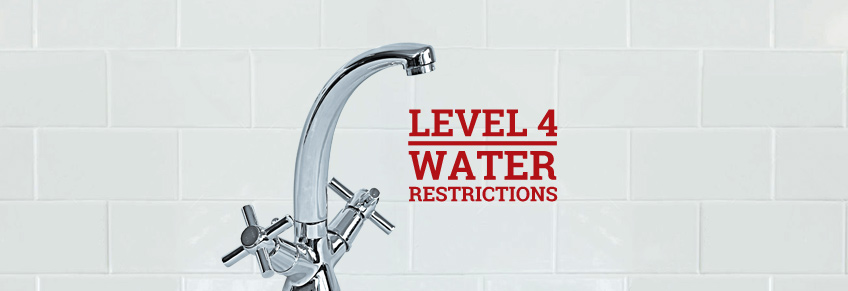Announcements
LEVEL 4 WATER RESTRICTIONS: What does it mean for you?
Level 4 water restrictions came into effect in the City of Cape Town on 1 June 2017. As you’ve probably heard, the Western Cape is currently experiencing its worst drought since 1904, necessitating each and every one of us to use water sparingly.
To make sure that we’re all saving enough water to ensure a consistent supply in the foreseeable future, we’re taking a closer look at what Level 4 means for you and your household, as well as what you can do to save more water.
BATHROOM:
- Flushing toilets with non-drinking water (such as greywater or rainwater) is encouraged.
- Showers should not be longer than 2 minutes.
- The maximum showerhead flow rate may not exceed 10 litres per minute.
IRRIGATION:
- Irrigation with municipal water is prohibited, while irrigation with non-drinking water is discouraged.
WASHING VEHICLES:
- Washing with municipal water is prohibited. Vehicles, boats or caravans may only be washed with non-drinking water or waterless products.
SWIMMING POOLS:
- Top-up, filling and refilling is prohibited.
- Use of portable play pools is prohibited.
- Use of pool covers is strongly encouraged.
OTHER:
- No hosing down of hard-surfaced or paved areas with drinking water.
- Wellpoints and boreholes must be registered with the City, and used responsibly to avoid wastage and evaporation.
The city and province are also urging citizens to maintain an overall consumption of
NO MORE THAN 100 litres per person per day.
How much is 100 Litres?
To stay within the 100-litre limit, you can essentially use the following amounts of water for each activity:
- 3L for Drinking
- 4L for Cooking
- 4L for Daily Hygiene (brushing teeth, washing your face, shaving, etc.)
- 20L for a 2-minute Shower
- 23L for Dishes and Laundry
- 36L for 4 Toilet Flushes
- 10L Saved
How to save even more
We believe it’s possible to save even more water – and your toilet is the ideal place to start. Below we’ve gathered a few simple things you can do to collect greywater for flushing purposes. And best of all, you don’t have to spend a lot of money to do so. All it takes is a bucket and a little effort.
- Use a bucket in the shower to collect water – especially when you’re waiting for the water to heat up, but also during your shower.
- Use a small bowl in the washbasin to collect water while washing your hands.
- Do the same when rinsing fruits and vegetables in the kitchen sink.
- If possible, the washing machine’s water can also be collected in buckets.
- If you wash your hair over the bathtub, simply put the bucket underneath to collect the water.
By employing all of these methods, and also remembering to flush the toilet only when it’s really necessary, you could even shut off your toilet’s water supply completely.
More information
To stay up to date on the latest water-restrictions or for more water-saving tips, be sure to visit the following websites:









